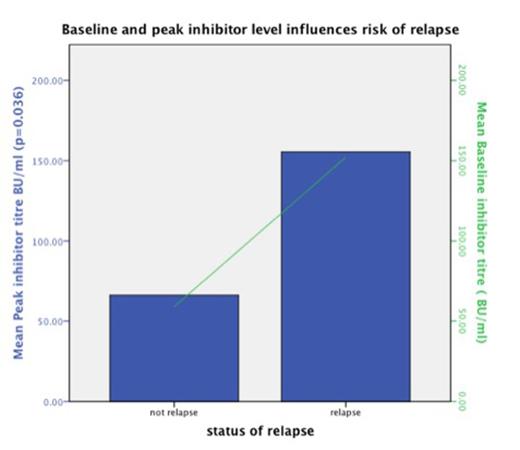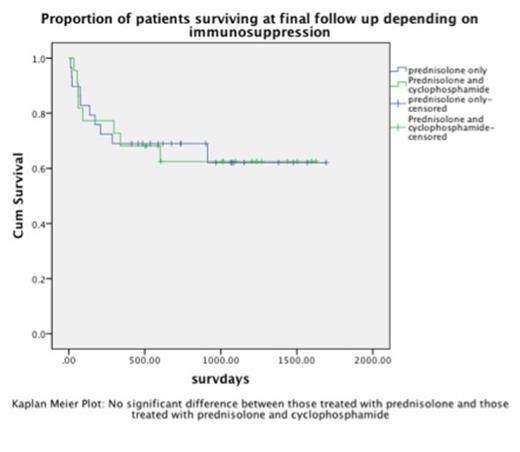Abstract

Background
Acquired haemophilia A (AHA) is a rare and potentially fatal bleeding disorder characterised by the development of autoantibodies directed against factor VIII. The optimal treatment for AHA remains uncertain and there is a paucity of published data to guide clinical practice. The EACH2 Registry has provided the largest observational dataset from 117 European centres on the management of AHA. The aim of this study is to provide retrospective analysis of the experience of all Haemophilia Centres across London on the management of AHA and compare it to the data presented in the EACH2 Registry.
Method
We performed a multicentre centre retrospective analysis of all AHA patients presenting between January 2009 and December 2012 to Haemophilia Centres across London. Data collected included demographics, aetiology, bleeding characteristics immunosuppression and haemostatic agents used to control the first bleeding episode.
Results
There were 65 patients identified. The median (IQR) age at diagnosis was 78 (57-85) years. At presentation, the median haemoglobin concentration, FVIII:C and inhibitor titre were 80 g/L (68-100), 2 IU/dl (0-5.5) and 13.0BU/ml(3.5-47 ).
At presentation 48/65 patients demonstrated bleeding from multiple sites with 18/65 experiencing life-threatening bleeds. 4 patients had no evidence of clinical bleeding and there was no difference in haemoglobin level, baseline FVIII:C and peak inhibitor titre compared to those who bled(P>0.05). 50% of patients had idiopathic cause of AHA with malignancy being the second most common.
Around 50% (33/65) of patients were treated with activated prothrombin complex concentrate (aPCC) alone and 19/65 patients alternated between aPCC and recombinant activated FVII (FVIIa). 6(9%) patients with bleeding symptoms were managed with tranexamic acid or desmopressin alone without bypassing agents.
There median (IQR) time to treatment response (defined as days to factor VIII >50IU/dl or negative Bethesda) was 45(23-82) days. Single agent prednisolone was most common (32/64) immunosuppression used followed by combination therapy with prednisolone and cyclophosphamide (22/64).
87% of patients achieved treatment response. A higher proportion of patients (21/22) treated with prednisolone and cyclophosphamide achieved response compared to prednisolone alone (29/33). There was no difference in the days to response (83 vs 69 p=0.055), time to remission (days to stopping immunosuppression)(123 vs 1958 p=0.065), incidence of relapses (7/32 vs 5/22) or duration of sustained remission (264 vs 204 p= 0.42) between the 2 groups. 8 patients received rituximab in addition to prednisolone and/or cyclophosphamide and 3 was treated with rituximab alone.
16% (12/65) of patients relapsed. These patients exhibited a higher mean baseline and peak inhibitor (BU/ml) (140 vs 54 p=0.011, 143vs 64 p=0.03) There was no difference in the time to response (78vs94 p=0.50) between patients who relapsed compared to those who did not. Presenting inhibitor of >16BU was also associated with longer days to treatment response(121 vs 58 p=0.001)
70% of patients were alive at follow up with similar portions seen in the between the cyclophosphamide and prednisolone group and prednisolone only group.
Summary:
Our study reinforced the findings of the EACH2 Registry that FVIII level and inhibitor tire did not correspond to the presence of bleeding or the severity of bleeding. However a low presenting inhibitor titre <16BU/ml was associated with faster inhibitor eradication and normalisation of FVIII. A higher baseline and peak inhibitor titre also influenced the rate of relapse. Bypassing agents were used to treat 91% of our patients with clinical bleeding, unlike only 70% in the EACH2 registry.
70 % of patients in the registry were treated with rFVIIa alone, which was observed in only 8% of our patients. The majority of our patients receive aPCC or alternating treatment between aPCC and rFVIIa. This selection preference for aPCC may be reflected by difference in the half life between the bypassing agents.
In contrast to the EACH2 Registry, we did not observe a shorter time to treatment response, a reduction in relapse rate or an increase in duration of sustained remission with the addition of cyclophosphamide to prednisolone.
Despite this, our study does concur with the EACH2 Registry that the final survival outcome was not affected by the choice of first line immunosuppression.
Luo:Grifols: Research Funding. Austin:Baxter: Speakers Bureau; Novonordisk: Honoraria, Speakers Bureau. Hart:Baxter: Speakers Bureau; Octapharma: Research Funding, Speakers Bureau; Novo Nordisk: Speakers Bureau; Pfizer: Speakers Bureau. Batty:Octapharma: Research Funding.
Author notes
Asterisk with author names denotes non-ASH members.

This icon denotes a clinically relevant abstract



This feature is available to Subscribers Only
Sign In or Create an Account Close Modal